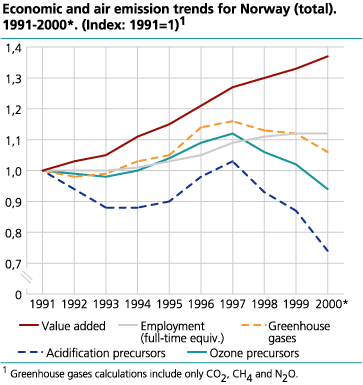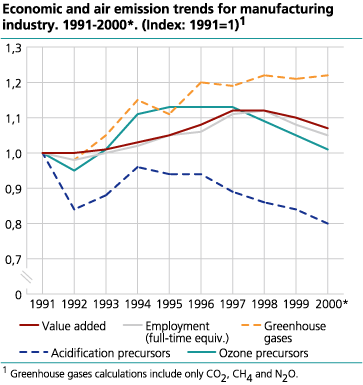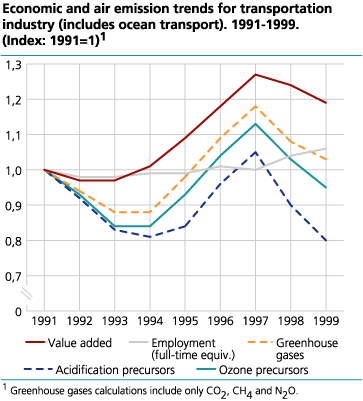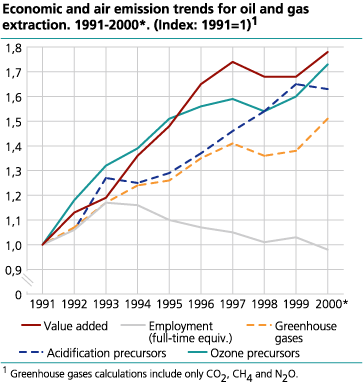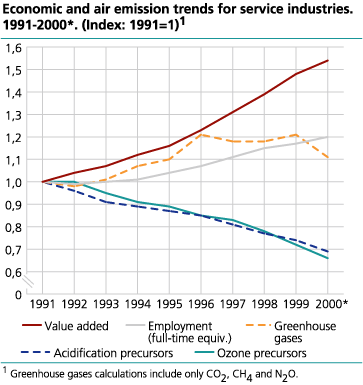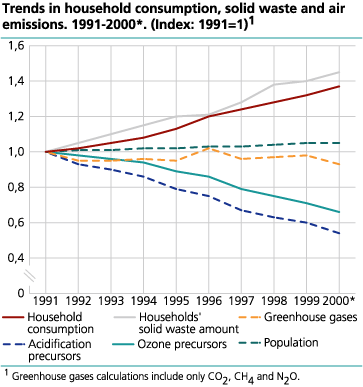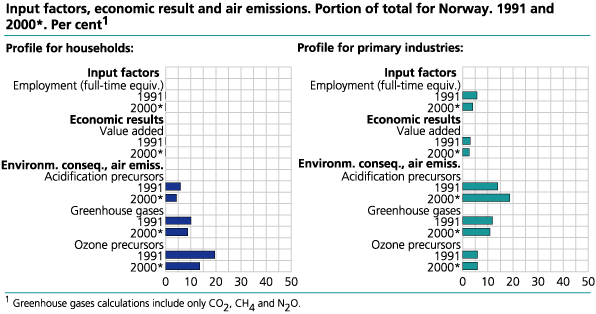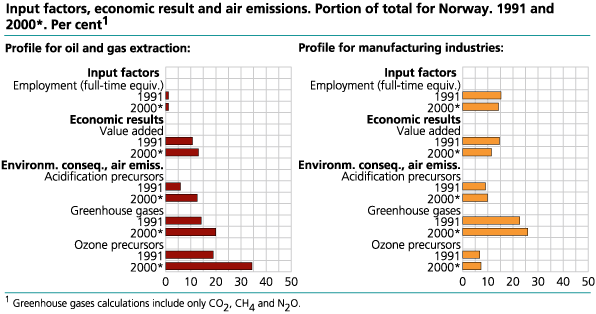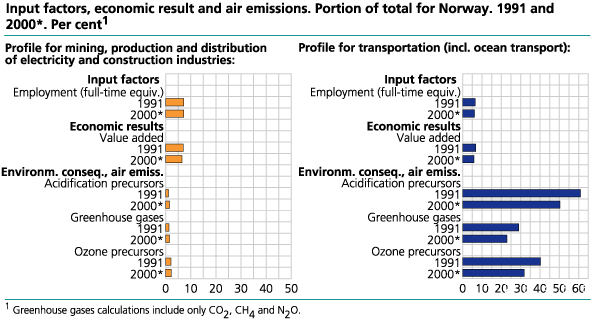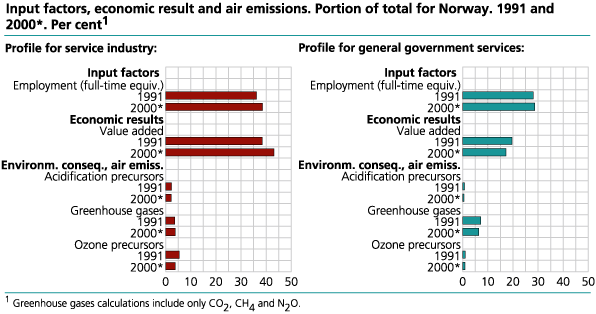Content
Published:
This is an archived release.
Higher growth in economy than in air emissions
The economic growth in Norway in the 1990s was greater than the increase in most types of air emissions. This is explained by the introduction of new technology but also by the growth in the services industries that has low air emissions. Detailed values show that the developments in oil and natural gas extraction and manufacturing industry are different from the national trends.
Household consumption and solid waste amounts are increasing steadily, whereas air emission types that contribute to acidification and ozone precursors are declining.
New statistics based on national accounts and environmental statistics are presented. These statistics can be used for benchmarking and comparing the development in economic growth and air emissions in the manufacturing industry and other branches.
Apparent weak connection between economic growth and emissions
Data for Norway as a whole indicates that the economic growth for the years 1991-2000 (measured by value added) was larger that the growth in most types of air emissions. The figure shows that value added and employment have developed in the opposite direction from the development in air emissions in the later years. From 1991 until 1996 the development was to a large extent in the same direction, but since 1997 the development for the economy and for air emissions have gone in separate directions.
Comparing industries
Although the economic growth is larger than the increase in emissions at the national level, examining trends at the industry level shows that the economic growth in several important industries has resulted in increased pressures on the environment. For the manufacturing industry and the transportation industry , the trends for acidification emissions are declining but the emissions of greenhouse gases continue to increase in relation to value added. For the extraction of crude oil and natural gas that is responsible for 13 percent of Norway's value added in 2000, there is a small decrease in greenhouse gas emissions in relation to value added, while other types of air emission types show almost no changes in relationship to the increase in value added.
There are two major explanations to Norway's improvements in emissions in relation to value added. The first is technological development and investment in new technology and in equipment that treats pollution. The other explanation is the increase in industries that are not pollution intensive. The figure to the right shows the trends in the services industry from 1991 to 2000. The services industries' proportion of total value added has increased from 38 to 43 percent, without an equivalent increase in the industry's air emissions levels.
Households: Higher consumption, less acid rain and ozone
For households the data from 1991 to 2000 show that consumption has increased over the entire period. The production of household solid waste per person also increased over the entire period but at a slightly lower rate than in the early years. The trends for emissions of components that contribute to acid rain and that are ozone precursors are decreasing. Emissions of greenhouse gases are relatively stable and do not follow the increase in consumption. Since the population development has increased less than consumption, the emissions per unit consumption show a larger decrease than the emissions per person.
Economic and environmental profiles
The Norwegian economy has been aggregated into eight industries. Economic - environmental profiles have been developed for each industry. These profiles show the percent of contribution by that portion of the economy to the economic results (value added), employment and air emissions for 1991 and 2000.
Environmental Accounts: Different definitions
There are major differences between these Norwegian National Accounts and Environment (NOREEA) air emissions data and the air emissions data that are published for Norway by Statistics Norway and the Norwegian Pollution Control Authorities (SFT). The NOREEA-data uses an economic definition of Norway whereas the official air emissions for Norway uses a geographic-based definition. The major difference between these data sets is the inclusion of air emissions from ocean transport and other international transportation activities in the NOREEA-data.
Emissions from Norwegian activity
Combining data from the national accounts and the air emissions accounts provides information about the environmental consequences of Norway's economic activity.
Results from the Norwegian Economic and Environment Accounts (NOREEA) will be published annually on Statistics Norway's website, usually in the late spring when the most recent estimates for both the air emissions data and the national accounts become available. The data tables being published now include a time series from 1991 - 2000 for economic, employment and air emissions data. The data for 2000 are only preliminary figures, and the data are published using the same industry categories as used for publishing the quarterly national accounts.
Tables:
- Table 1 Gross value added by industry and household consumption in constant 1995-prices. Million NOK (basic prices)
- Table 2 Employment, full-time equivalent persons. Employees and self-employed. 1 000
- Table 3 NOREEA - Emissions to air of carbon dioxide, (CO 2 ). Tonnes
- Table 4 NOREEA - Emissions to air of methane (CH 4 ). Tonnes
- Table 5 NOREEA - Emissions to air of nitrous oxide (N 2 O). Tonnes
- Table 6 NOREEA - Emissions to air of sulfur dioxide (SO 2 ). Tonnes
- Table 7 NOREEA - Emissions to air of nitrogen oxides (NO x ). Tonnes
- Table 8 NOREEA - Emissions to air of ammonia (NH 3 ). Tonnes
- Table 9 NOREEA - Emissions to air of lead (Pb). Tonnes
- Table 10 NOREEA - Emissions of cadmium (Cd). Kilograms
- Table 11 NOREEA - Emissions of mercury (Hg). Kilograms
- Table 12 NOREEA - Emissions of PAH-4. Tonnes
- Table 13 NOREEA - Emissions of carbon monoxide (CO). Tonnes
- Table 14 NOREEA - Emissions of particulates. Tonnes
- Table 15 NOREEA - Emissions of non-methane volatile organic carbons (NMVOC). Tonnes
- Table 16 NOREEA - Emissions of dioxins. Grams
Additional information
Contact
-
Ingrid Semb Weyer
E-mail: ingrid.semb.weyer@ssb.no
tel.: (+47) 40 90 23 51
-
Trine Heill Braathu Randen
E-mail: trine.heill.braathu.randen@ssb.no
tel.: (+47) 91 10 67 45

